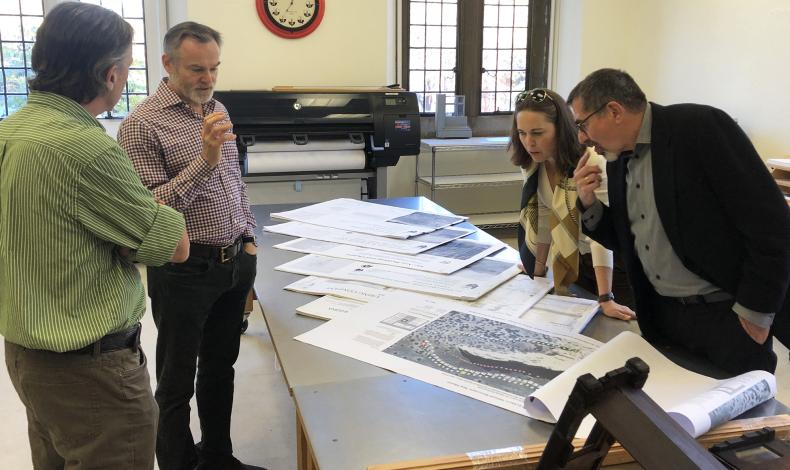Preservation Graduate’s Gift Supports New Space for Center for Architectural Conservation

A new space for the Center for Architectural Conservation (CAC) at Penn.
Over the course of almost thirty years, Frank Matero, professor and chair of historic preservation at the Weitzman School, has built the Center for Architectural Conservation (CAC) at Penn into a leading research and training facility for young architectural conservators, fostering partnerships with institutions like the National Park Service, the National Trust for Historic Preservation, and the Getty Conservation Institute. In just the last few years, the Center has conducted research and field work at many national parks and monuments, including the ruins of Pecos, Wupatki, Tumacacori, Fort Union National Monument, the modernist concrete Jackson Lake Lodge, the John Moulton Homestead in Grand Teton National Park, and Taliesin and Taliesin West — two landmark residences designed by Frank Lloyd Wright. While the sites vary in age, type and issue, from climate vulnerability to technological obsolescence, they all share the potential to further applied research and training for young professionals.
Until last summer, the CAC operated out of 1,000 square feet in Duhring Wing it had long ago outgrown. But starting in May, Matero and his colleagues packed up the old center — founded as the Architectural Conservation Lab in 1991 — and moved it to a newly renovated 2,000 square-foot space across campus, at 4201 Spruce Street. Now, the CAC, which gives students expanded opportunities to work on professional conservation projects, can host meetings of professional researchers and public-facing events to raise the profile of preservation work at Penn.
“We have to create more effective places for students, faculty, and guests to meet, discuss, and debate,” Matero says. “We need the equivalent of a Kelly Writers House for architectural conservation. We don’t have enough of such places for our students in Meyerson Hall. This was a major move for us to be able to create this space to then activate expanded programming.”
The renovation of the new space was supported by Dawn Gonick, a 1994 graduate of the Master of Science in Historic Preservation, and her husband Brian, who received his undergraduate degree from Wharton in 1986. Dawn says that her high school commencemnt speech, given by Jeanne-Marie Teutonico, now the associate director of programs at the Getty Conservation Institute, planted the seed of her interest in preservation. At Penn, Gonick — “One of my best students,” Matero says — concentrated on conservation science, and working with the Center provided her real-world experience with sites like El Morro National Monument and Mission San Juan Capistrano. After graduating, she worked as project manager for Integrated Conservation Resources, and subsequently with the New York Landmarks Conservancy and Historic House Trust of New York City.
“As a student, I was fortunate to have been involved in a couple of projects with the Center. My thesis work was supported by a grant from the National Parks Service and the work I did for my andvanced certificate in conservation was also a project organized through the Center, so there’s a very personal relationship there. I benefited tremendously from the Center’s mission of providing students with opportunites for applied research and practical hands-on work.”
In 2014, Gonick and her husband also created the Dawn and Brian Gonick Architecture Conservation Professional Development Fund, which helps students concentrating in architectural conservation attend professional-development conferences and activities in the field.
Matero says the CAC’s new space will also host a preservation clinic, as well as Change Over Time, the semiannual built-environment conservation journal edited by Matero and Kecia L. Fong. The journal recently hosted a panel on LGBTQ heritage to coincide with the release of its new issue. That panel was held in the Morgan Building, but Matero says that similar events in the future may be held in the new Center for Architectural Conservation. The Center also plans to convene conversations about climate change and cultural preservation and new conservation technologies, like the ATVs or drones that the Center has experimented with at heritage sites like Fort Union.
“The CAC plays an essential role in teaching students skills they will use as professionals, but they also have the ability to help advance the field of preservation because they’re doing cutting-edge research and field work on historic sites that can’t necessarily happen in a for-profit environment,” Gonick says.
Gonick says the Center, under Matero’s leadership, has been exceptional at building partnerships with public and private institutions and finding sponsored internship and research opportunities for students since the time she spent there in the 1990s. And the new space will help take its work even further. Preservation is a collaborative field, Gonick says, so it’s important for the Center to have enough space to bring people together.
“There’s all of this interdisciplinary work that happens, and the cross-pollination between departments and disciplines when you get people across the table from each other working on projects — that’s exciting, and potentially innovative.”

